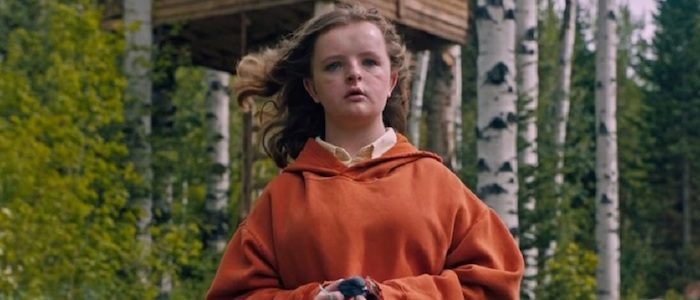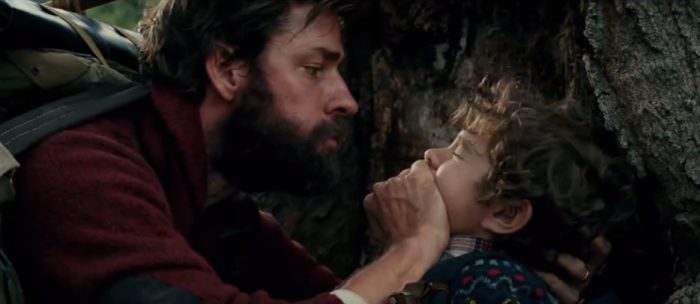How 2018 Horror Explored Disability – And Represented It For The Better
2018 created a common thread within the horror genre: stories contained a family drama at their core while utilizing disabilities and themes of loss to augment tension and fear. Disabilities displayed on screen ranged from food allergies to vision loss and hearing impairments. Monsters and elements of the supernatural served as secondary plot devices, while primary storylines navigated the psychological depths within the nuclear family as a result of the body's limitations to enhance the severity of grief and survival, all while providing much needed representation of marginalized communities.Spoilers for Hereditary, Bird Box and A Quiet Place follow. Loss of control is a primal fear many individuals experience, and in regards to the human body mostly pertains to aging and terminal illnesses. In Ari Aster's Hereditary, he brilliantly utilizes a somatic approach to the themes of residency within the physical form by providing a faithful representation of anaphylaxis and subsequently raises awareness of the food allergy community.A pivotal turning point in the film occurs when Charlie, the youngest of the Graham family, experiences a life-threatening reaction from ingesting a cake containing nuts while accompanying her brother to a house party. The use of a deadly nut allergy to ignite the themes of control and loss are an astute decision; and for once, anaphylaxis is accurately portrayed on film in all of its horrific, deadly detail. Like the dissension of madness among the family, Charlie's reaction starts off slow as she drinks water to calm the tingle in her throat. Soon after, she tells her brother that her throat is "getting bigger", finally gasping for air and violently thrashing around in the backseat of the car as her brother rushes her to the hospital. She appears to be choking as she grasps her neck while her throat is closing up. Desperate to get air, she sticks her head out the window, leading to her death in a different manner – the food allergy slyly serving as a red herring.Films have notoriously portrayed food allergies through comedy as seen in Hutch and Horrible Bosses. The severity is undermined as food allergies are typically viewed as a character trait used for a cheap laugh or for an opportunistic bully to assert authority. The most recent reference was seen in Peter Rabbit, which caused an uproar of protest. Diminishing the severity of a deadly allergic reaction in a child's movie was neglectful to say the least and a jab to the food allergy community – especially since food allergies in children have increased 50 percent between 1997 and 2011, according to FARE (Food Allergy Research & Education).However, Aster delivers an accurate depiction of anaphylaxis and concurrently stresses the importance of carrying an EpiPen auto-injector while inserting subtle clues into the film's plot and character development. For example, in the beginning of the film, Charlie's mother is very aware of her allergy. She makes sure the chocolate bar Charlie eats does not contain nuts because she doesn't have the EpiPen with her, which is odd because from a motherly perspective, having life-saving medication readily on hand is crucial for your child's safety. The anaphylactic reaction is the first form of foreshadowing and displays the characters' limitations in establishing dominion over their bodies. This is further exemplified in the film through experiences of unplanned pregnancy, sleepwalking, schizophrenia, and demonic possession. Aster masterfully depicts food allergies in a realistic manner while uniquely layering themes, driving the storyline, and developing character arcs.Progressive representation for this particular group (yes, food allergies are covered under the American Disability Act) is therefore a by-product of the plot, and its use in Hereditary showcases the innovative depths to which the condition can be used to both scare and educate audiences. Although it is categorized as a disability, the experiences and stigma vastly differ from physical disabilities which involve limited to no mobility.
Loss of control is a primal fear many individuals experience, and in regards to the human body mostly pertains to aging and terminal illnesses. In Ari Aster's Hereditary, he brilliantly utilizes a somatic approach to the themes of residency within the physical form by providing a faithful representation of anaphylaxis and subsequently raises awareness of the food allergy community.A pivotal turning point in the film occurs when Charlie, the youngest of the Graham family, experiences a life-threatening reaction from ingesting a cake containing nuts while accompanying her brother to a house party. The use of a deadly nut allergy to ignite the themes of control and loss are an astute decision; and for once, anaphylaxis is accurately portrayed on film in all of its horrific, deadly detail. Like the dissension of madness among the family, Charlie's reaction starts off slow as she drinks water to calm the tingle in her throat. Soon after, she tells her brother that her throat is "getting bigger", finally gasping for air and violently thrashing around in the backseat of the car as her brother rushes her to the hospital. She appears to be choking as she grasps her neck while her throat is closing up. Desperate to get air, she sticks her head out the window, leading to her death in a different manner – the food allergy slyly serving as a red herring.Films have notoriously portrayed food allergies through comedy as seen in Hutch and Horrible Bosses. The severity is undermined as food allergies are typically viewed as a character trait used for a cheap laugh or for an opportunistic bully to assert authority. The most recent reference was seen in Peter Rabbit, which caused an uproar of protest. Diminishing the severity of a deadly allergic reaction in a child's movie was neglectful to say the least and a jab to the food allergy community – especially since food allergies in children have increased 50 percent between 1997 and 2011, according to FARE (Food Allergy Research & Education).However, Aster delivers an accurate depiction of anaphylaxis and concurrently stresses the importance of carrying an EpiPen auto-injector while inserting subtle clues into the film's plot and character development. For example, in the beginning of the film, Charlie's mother is very aware of her allergy. She makes sure the chocolate bar Charlie eats does not contain nuts because she doesn't have the EpiPen with her, which is odd because from a motherly perspective, having life-saving medication readily on hand is crucial for your child's safety. The anaphylactic reaction is the first form of foreshadowing and displays the characters' limitations in establishing dominion over their bodies. This is further exemplified in the film through experiences of unplanned pregnancy, sleepwalking, schizophrenia, and demonic possession. Aster masterfully depicts food allergies in a realistic manner while uniquely layering themes, driving the storyline, and developing character arcs.Progressive representation for this particular group (yes, food allergies are covered under the American Disability Act) is therefore a by-product of the plot, and its use in Hereditary showcases the innovative depths to which the condition can be used to both scare and educate audiences. Although it is categorized as a disability, the experiences and stigma vastly differ from physical disabilities which involve limited to no mobility. FARE studies show food allergies affect up to 15 million Americans, while the CDC reports 3.4 million Americans above the age of forty are affected by vision loss. Visual impairment or blindness, usually resulting from age-related diseases, is a disability commonly used in film to arouse a sense of pity for blind characters. Other films display blindness as a journey by following characters as they adapt to their new reality to lead a life as normal as possible, while some films display blindness to heighten a perceived sixth sense.Based on Josh Malerman's book of the same name, Bird Box addresses vision and blindness in a post-apocalyptic world where opening one's eyes while outside causes them to commit suicide. A group of survivors stranded in a house quickly adapt by boarding up all the windows, wearing blindfolds while outdoors, and using wire to track distances on supply runs. While reception is polarizing and the depiction of the mentally ill is questionable, Bird Box delivers promising representation for the blind community.For one, the film does not approach blindness as a burden, nor does it evoke pity; instead, it's portrayed as a tool for survival. In the first scene, Malorie (Sandra Bullock) addresses her two children, "Boy" and "Girl", telling them about their upcoming journey. Firmly and authoritatively, she emphasizes the direness of the trip, telling them she will hurt them if they remove their blindfolds and to listen to their surroundings because "if you look, you will die." A similar approach is used in the biopic, Ray, when the mother of young Ray Charles teaches him to survive on his own with tough love. While it may seem harsh, both films address vision loss with a sense of resiliency and fostered independence.
FARE studies show food allergies affect up to 15 million Americans, while the CDC reports 3.4 million Americans above the age of forty are affected by vision loss. Visual impairment or blindness, usually resulting from age-related diseases, is a disability commonly used in film to arouse a sense of pity for blind characters. Other films display blindness as a journey by following characters as they adapt to their new reality to lead a life as normal as possible, while some films display blindness to heighten a perceived sixth sense.Based on Josh Malerman's book of the same name, Bird Box addresses vision and blindness in a post-apocalyptic world where opening one's eyes while outside causes them to commit suicide. A group of survivors stranded in a house quickly adapt by boarding up all the windows, wearing blindfolds while outdoors, and using wire to track distances on supply runs. While reception is polarizing and the depiction of the mentally ill is questionable, Bird Box delivers promising representation for the blind community.For one, the film does not approach blindness as a burden, nor does it evoke pity; instead, it's portrayed as a tool for survival. In the first scene, Malorie (Sandra Bullock) addresses her two children, "Boy" and "Girl", telling them about their upcoming journey. Firmly and authoritatively, she emphasizes the direness of the trip, telling them she will hurt them if they remove their blindfolds and to listen to their surroundings because "if you look, you will die." A similar approach is used in the biopic, Ray, when the mother of young Ray Charles teaches him to survive on his own with tough love. While it may seem harsh, both films address vision loss with a sense of resiliency and fostered independence.
In Bird Box, shots feature a cloth fully covering the screen which inserts the viewer into the characters' experience. This method garners empathy while simultaneously heightening tension. Encountering a group of blind individuals ultimately becomes their refuge. Normally, there is a societal stigma in which people assume those who are blind may not be fit for the world. However, the narrative shows that just as blind individuals can adjust to their surroundings, so can fully able-bodied individuals adjust to their new reality in this post-apocalyptic scenario. One's weakness may be considered another's strength, and vice versa.
The employment of blindness as a plot device is also an apt metaphor for the uncertain journey of motherhood. As a devoted artist, Malorie is always apprehensive and aloof about her pregnancy. She worries she won't bond with her children, volunteers for dangerous rescue missions while pregnant, and tries to dismiss her condition when her water breaks, repeating "it's not happening" over and over again. All of these actions can also resonate with individuals who experience the development of a disability. If one develops a disability over time, accepting a new way of life through unforeseen challenges contains its own initial elements of denial and fear.The dehumanization of naming her children "Boy" and "Girl" implicates Malorie's emotional reserve as she sees death in this new world as inevitable. However, once they reach safety, she discloses their true names and embraces her role as a mother as well as the innocent role of her children, allowing them to simply be kids who can carelessly play together instead of strictly train for combat and survival. Director Susanne Bier presents blindness as a virtue and a sense of relatability through a resistant mother's need to protect her children, showing that disabilities can be portrayed in an array of storylines while breaking traditional tropes, as well as generating empathetic awareness from audiences. One of the biggest films of the year grossing over $340 million worldwide, A Quiet Place took the silence trope to new levels while providing inclusion on set and a "Deaf Gain" within its narrative.
One of the biggest films of the year grossing over $340 million worldwide, A Quiet Place took the silence trope to new levels while providing inclusion on set and a "Deaf Gain" within its narrative.
A term coined by Dirksen Bauman and Joseph J. Murray, "Deaf Gain" encompasses "the myriad ways in which both deaf people and society at large have benefited from the existence of deaf people and sign language" throughout history. This is exemplified in A Quiet Place by strong sound design and the use of American Sign Language (ASL) as an advantageous survival skill in a post-apocalyptic world where the slightest noise triggers an attack from creatures who hunt via echolocation.
In the beginning of the film, the stakes are established when the youngest member of the Abbott family turns on a toy rocket given to him by his older sister, Regan (Millicent Simmonds). His tragic death causes a ripple of grief as Regan blames herself and sinks into a strained relationship with her father. Patriarch of the family, Lee (John Krasinski), works tirelessly to fix a cochlear implant which later becomes a key plot mechanism. It represents Lee's unconditional love and dedication to his daughter as well as Regan's return to a sense of normalcy. After multiple attempts, Lee once more presents the newest prototype which a frustrated Regan refuses, begging him to stop. This scene alone will resonate with anyone who suffers from a disability. Despite the best intentions from family, doctors, and friends, most efforts are unsuccessful; and there is an exhausting challenge to maintain hope with realistic expectations of a cure or solution.The use of ASL and casting of Simmonds (who is deaf in real-life) are some of the most impactful aspects of the film. The rest of the cast learned ASL, and interpreters were brought on set to streamline communication. Simmonds' talent and ease on set displays an empowering sense of ability and equality that proves individuals with disabilities can work in Hollywood and can be cast in roles portraying their disabilities. The film's authenticity with casting Simmonds, along with husband-wife duo John Krasinski and Emily Blunt as the Abbott parents, further drives the emotional aspects behind the film. There is a palpable connection between the characters – a component that makes horror truly terrifying by being relatable. By the time the audience learns Ragen is deaf, she is a multi-faceted character harnessing the responsibilities of being the oldest sibling, and her lack of hearing is not merely a plot device, but a part of who she is. Ragen's impairment isn't fetishized, as her storyline is complex and not solely defined by a disability. This portrayal strays from evoking mere pity; instead requiring Ragen to earn her redemption as she consistently tries to prove her capability by volunteering to accompany her dad in learning survival tactics when her younger brother is reluctant to do so. Fellow /Film contributor Kristen Lopez does a fantastic job at diving further into the film's progressive representation.Aster, Bier, and Krasinski harness the human body to propel themes of loss, residency, and autonomy within the horror genre. In regards to the political and social commentary of A Quiet Place, Krasinski stated "The best compliment you can get on any movie is that it starts a conversation". All three of these films have the opportunity to start (and continue) conversations about the representation of invisible and physical disabilities on camera. Some topics include how people with disabilities can successfully be portrayed outside of stereotypical and one-dimensional tropes; how films can intertwine a sense of normalcy within daily lives; and, the benefits of casting actors to play disabled roles.Although there are nearly 40 million Americans with disabilities according to the U.S. Census Bureau, it is rare to see disabled characters in film, and only four Oscars have been awarded to people with visible disabilities: Harold Russell (1947), Linda Hunt (1984), Marlee Matlin (1987), and Dan Keplinger (1999). Films have the ability to influence viewers and change perceptions by dismantling stereotypes for marginalized groups. While people with disabilities are usually subjected to pity and discrimination through ableism, these three films are examples of responsibly creative portrayals of disabilities. Inclusive casting, accurate representation, and the ability to utilize disabilities as a narrative tool within the universal aspects of the human condition are all beneficial to our society and can redefine commonly held notions about disability and normalcy while embracing human diversity.
